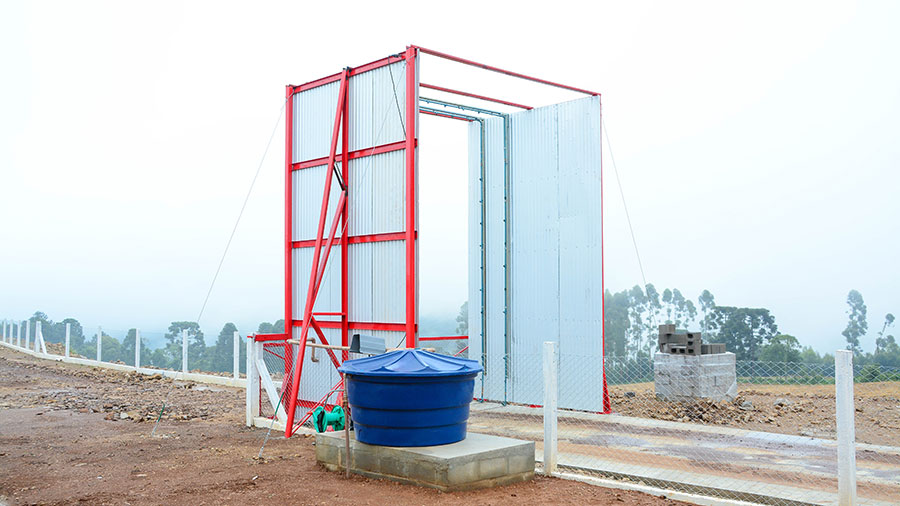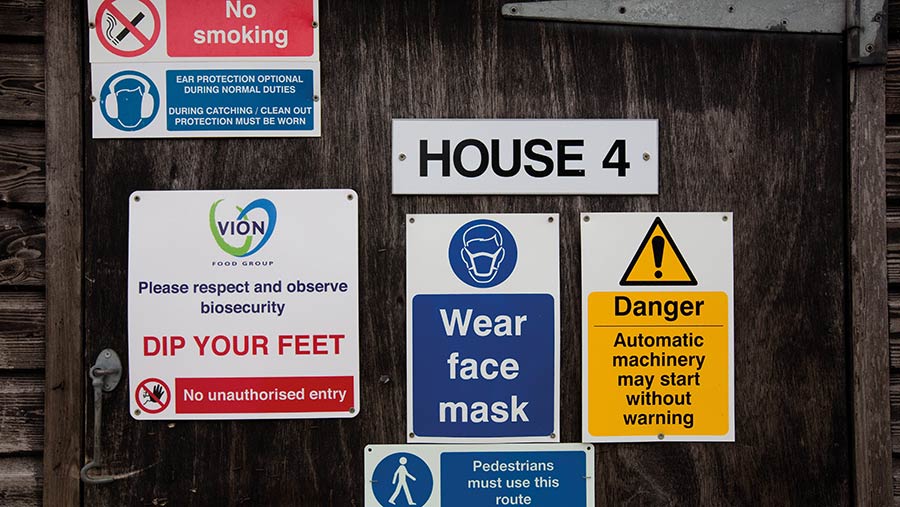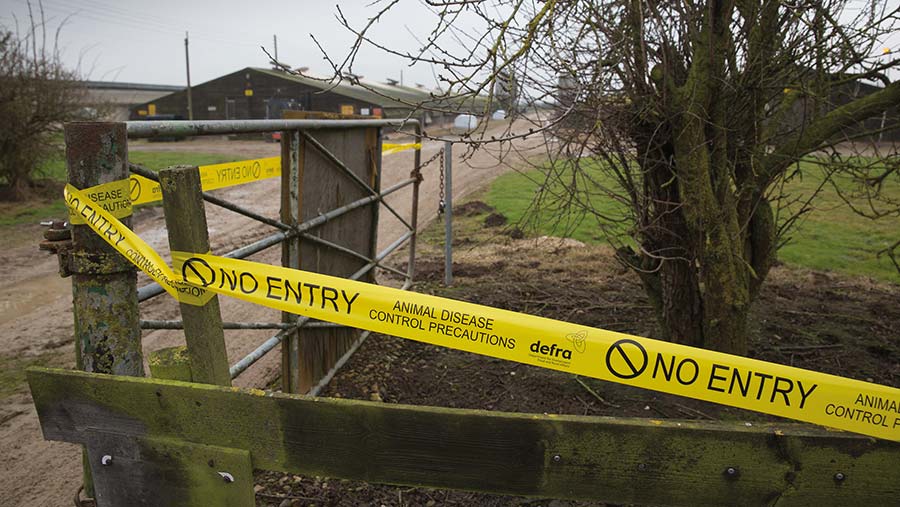Avian influenza prevention tips and how to handle an outbreak
 © AdobeStock/cratervalley
© AdobeStock/cratervalley Avian flu is every poultry producer’s worst fear; infection can cause widespread mortality, and confirmation of the disease will usually trigger a cull of the flock, followed by stringent cleaning and disinfection measures.
Producers are not able to restock until at least 21 days after the clean-down has been approved, and movement restrictions will be put into place.
Although there is compensation available for slaughtered birds, any that die naturally from the disease are not paid for, so losses can be considerable.
See also: Avian influenza: One farm’s robust plans to combat the threat
General biosecurity considerations
The disease is spread by direct bird-to-bird contact, through contaminated body fluids and faeces, or through contaminated water, feed, vehicles, clothing and footwear.
This means stringent biosecurity is the key to minimising the risk of avian influenza (AI).
- To stop any bugs from spreading between sheds, equipment must not be shared, and ideally there should be a physical barrier between clean and dirty areas, with separate clothing and footwear for each.
- Make covered foot-dips using Defra-approved disinfectant available outside all entrances, and assign staff to specific houses.
- Keep a visitor’s book and minimise access to the site, disinfecting all vehicles on arrival.
- Personal Protective Equipment (PPE) should be issued at the biosecure point to any visitors, and a disposal bin should be available.
- Feed – and, just as importantly, bedding – needs to be kept clean and away from anywhere that could be accessed by wild birds and rodents.
- Ensure all staff are trained in biosecurity measures, as well as clinical signs of the disease for prompt identification and action.
- Keep areas where birds live clean and tidy and regularly disinfect paths and walkways.
Range management measures

© Tim Scrivener
Free-range birds are most at risk from AI, given the difficulty in controlling their environment. Lakes and ponds and puddles are all a potential risk for disease spread from wild birds.
- Ensure the range is well drained and fence off wetland areas.
- Do a full risk assessment with your vet and minimise contact with wild birds
- Try scarecrows and flags as scarers if your chickens are used to them, and walk around your range frequently as a physical deterrent.
- Swap outdoor and indoor boots where possible to reduce the risk of contaminating the shed.
- Clear up feed spillages and clean and disinfect any hardstanding regularly. Some people apply lime to the range to kill pathogenic bugs.
- Check fencing, too – holes can allow hens to move from house to house, or let wild birds in.
How to recognise AI in your flock
There are two types of AI – highly pathogenic (HP) and low pathogenic (LP).
Both have similar symptoms, but the HP strains are much more virulent and can wipe out an entire flock in a short space of time. In LP strains, mortality in flocks is usually low unless accompanied by secondary bacterial or viral infections.
Clinical signs can vary between species and some may show minimal clinical signs (ducks and geese).
Symptoms of HPAI
Flock
- Sharp fall in productivity
- High mortality
- Appetite loss and birds become quiet, dull or unwilling to move
Individual birds
- Respiratory distress such as gaping beak, coughing, sneezing, gurgling, rattling
- Nasal or oral discharge, possibly blood-tinged.
- Swollen head, and blue wattle or comb (and snood in turkeys).
- Diarrhoea.
- Swelling and red discoloration of the shanks and feet.
Symptoms of LPAI
Symptoms for LP strains are more subtle and sometimes absent and the disease may take longer to identify.
- It can cause mild breathing problems, but affected birds will not always show clear signs of infection.
- There may be decreased egg production or infertility.
- Diarrhoea.
- Loss of appetite.
What to do if AI is suspected
AI is a notifiable disease, so producers must immediately report it to the authorities.
- England – call Defra on 03000 200 301
- Wales – call 0300 303 8268
- Scotland – contact the local Field Services Office.
Failure to contact the relevant authority is an offence. Dead wild birds – particularly waterfowl – should also be reported.
On receiving notification of an outbreak, the government authority will assess the situation and send a vet to establish if the disease is present and whether it is likely to have spread.
They will most likely put in place movement restrictions and may impose restrictions on other farms in the local area.

© Tim Scrivener
If AI is confirmed, the whole flock will usually have to be culled and disposed of, followed by a thorough clean-down and disinfection of housing that must be signed off by the Animal and Plant Health Agency (Apha).
Limited restocking of sentinel birds may then be allowed to confirm that the disease is no longer present, and full restocking may be permitted 21 days after secondary disinfection.
What if there’s an outbreak in the area?
Protection zones – Depending on the severity of the outbreak and the strain of the disease, Defra may impose movement restrictions, protection zones and surveillance zones in the area.
Protection zones are typically within a 3km minimum radius and surveillance zones cover at least 10km from the outbreak.
Housing – Poultrykeepers will usually be asked to house birds until further notice – and it is part of the Lion Code assurance that producers are prepared to house at short notice.
This means ensuring sufficient bedding, feed and labour to look after the birds’ welfare.
“There is a risk of increased stress and aggression, so inspect the birds frequently to check they’re not feather pecking,” says Mrs Mouland.
Environmental enrichment may relieve boredom, or the vet can prescribe a calming agent to put into the water.
Record-keeping – One of the most challenging things, if caught in an outbreak, can be accurately tracing the disease source.
Every possible vector of the virus will be explored, and those without detailed farm records will delay the time it takes to get up and running again.
It’s well worth keeping a copy of this off site, or stored digitally, for easy access in the event of an outbreak.
Latest thinking on the disease
The UK has been free from avian influenza since 13 June 2020.
However, outbreaks of highly pathogenic AI (the H5N8 strain) have been found in poultry and wild birds in several countries across Europe.
These include Russia, Kazakhstan, Bulgaria and Hungary, with high mortality in both commercial poultry and wild birds.
The European Centre for Disease Prevention and Control issues regular updates on AI outbreaks and is urging EU states to step up surveillance and biosecurity measures this winter.
It follows outbreaks of HPAI in western Russia and Kazakhstan: a known autumn migration route for wild water birds heading to Europe.
According to the report, Northern and eastern Europe are likely to be the most vulnerable to new outbreaks.
When HPAI was detected in the same area of Russia in the summers of 2005 and 2016, epidemics followed in northern and eastern Europe.
If the pattern is repeated this year, HPAI is expected to arrive in the same areas of Europe in autumn or winter. Subsequent spread to countries in southern and western Europe is also possible.
Spread of the virus is likely to be triggered by a sudden and persistent fall in temperatures in central Russia and Kazakhstan.
Several studies demonstrate that cold weather conditions led to the rapid westward expansion of the HPAI virus by infected migratory birds during the 2005-06 and 2016-17 waves.
In the UK, high-risk areas are those that attract migratory wildfowl.
An interactive AI risk map is available on the Defra website, along with detailed guidance.
